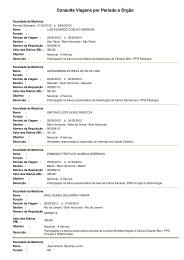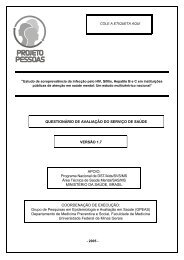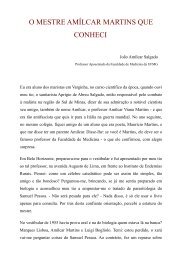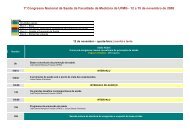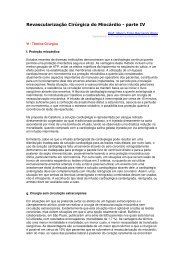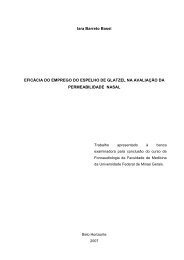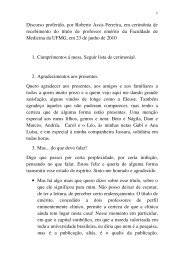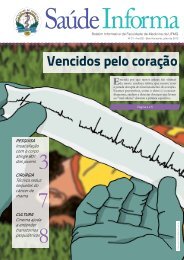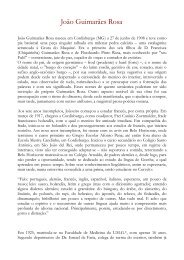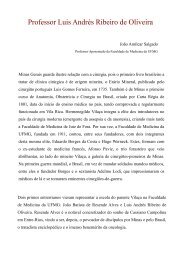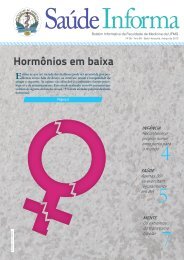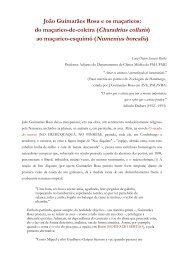Psiquiatria - Faculdade de Medicina - UFMG
Psiquiatria - Faculdade de Medicina - UFMG
Psiquiatria - Faculdade de Medicina - UFMG
Create successful ePaper yourself
Turn your PDF publications into a flip-book with our unique Google optimized e-Paper software.
CONSIDERING THE SLEEP APNEA HIPOPNEA RERA SYNDROME IN THE<br />
DIFFERENTIAL DIAGNOSE OF PSYCHIATRIC DISORDERS<br />
CONSIDERANDO A SÍNDROME DE APNÉIA HIPOPNÉIA ARER NO<br />
DIAGNÓSTICO DIFERENCIAL DE TRANSTORNOS PSIQUIÁTRICOS<br />
Dirceu <strong>de</strong> Campos Valladares Neto*<br />
Summary<br />
It is not rare to see patients complaining to the psychiatrist of<br />
<strong>de</strong>pression, insomnia, apathy, lack of motivation and hypersomnia<br />
who do not respond to anti<strong>de</strong>pressants (AD). Obstructive sleep<br />
apnea hypopnea syndrome (OSAHS) with respiratory effort-related<br />
arousal (RERA) is frequently not consi<strong>de</strong>red in the differential diagnosis<br />
or as a second diagnostic, which can lead to frustration to both<br />
doctors and patients. OSAHS is not a rare condition, affecting 4% to<br />
6% of the general population. In Brazil six to eight million people suffer<br />
from OSAHS, most of them not diagnosed or misdiagnosed and<br />
incorrectly treated. OSAHS is also associated with infarct of myocardial,<br />
strokes, hypertension, a seven fold risk in automobile acci<strong>de</strong>nts<br />
and represents a social bur<strong>de</strong>n.The purpose of presenting this case<br />
is to call attention for OSAHS in the psychiatric population due to a<br />
ten<strong>de</strong>ncy to obesity for using neuroleptics and AD, and due to the<br />
frequent use of benzodizepines, which are prohibited to OSAHS<br />
patients for relaxing the muscles during sleep and worsening the<br />
condition. Herein we present a case history of an 56 years old<br />
OSAHS patient who already had stroke, infarct of myocardial and<br />
suffered somnolence during the day, lack of motivation, apathy,<br />
<strong>de</strong>pression, initial insomnia and memory difficulties.<br />
Key-words: OSAHS, Depression, RERA, Insomnia,<br />
Benzodiazepines, AD, Apnea, Anxiety, Dementia.<br />
Case history<br />
A 63-year-old retired lawyer presented at our sleep disor<strong>de</strong>r<br />
center complaining excessive daytime sleepiness that appeared to<br />
be related to his very disturbed nighttime sleep. He weighed<br />
74 kilos, which was a normal weight for his height and age but he<br />
was a loud snorer and his wife noticed “apneic episo<strong>de</strong>s” during<br />
sleep. He already had a stroke five years ago which reduced<br />
the movements of his right arm. He also had a myocardial<br />
infarct three years ago. Lack of motivation, apathy, <strong>de</strong>pression<br />
and memory difficulties were also present. He fulfilled the diagnostic<br />
criteria of major <strong>de</strong>pression episo<strong>de</strong> (DSM-IV) and was in<br />
use of AD (maprotiline, 75 mg/day) and a hypnotic (flurazepan,<br />
30 mg/day).<br />
He un<strong>de</strong>rwent all-night polysomnography, which showed a<br />
total sleep time of only 204 minutes with a sleep efficiency of<br />
* Psychiatrist, sleep disor<strong>de</strong>rs clinican, member of the American<br />
Aca<strong>de</strong>my of Sleep Medicine.<br />
56%. He also displayed breathing disturbances during sleep. It<br />
was scored 35 apneic/ hipopneic episo<strong>de</strong>s per hour, his <strong>de</strong>ssaturation<br />
oxigen level was at the range of 64% and 95%, with a<br />
mean of 89 ± 6,7%. He presented more than 370 arousals during<br />
the night that were evi<strong>de</strong>nt on the electroencephalogram during<br />
sleep (Figure 1).<br />
This findings led to a diagnosis of obstructive sleep hipopnea<br />
apnea syndrome. The patient started to use a CPAP (continuous<br />
positive airway pressure <strong>de</strong>vice) during sleep time which dramatically<br />
improved the quality of his nighttime sleep (Figure 2) and<br />
diminished his ten<strong>de</strong>ncy for daytime sleepiness. It also improved<br />
his mood, his level of energy and his blood pressure, <strong>de</strong>creasing<br />
its rates. He also noticed improvement of his memory skills.<br />
Discussion<br />
Sleep-related breathing disor<strong>de</strong>rs (SRBD)- breathing disor<strong>de</strong>rs<br />
that are induced or exacerbated during sleep - are very common.1,2<br />
There is a positive relation between SRBD and obesity<br />
and between SRBD and aging, although SRBD can occur in those<br />
not obese and in all ages.1 It occurs twice in man compared to<br />
woman but this gen<strong>de</strong>r difference tends to be reduced or even<br />
matched within el<strong>de</strong>rly people. Mood swings, <strong>de</strong>pression, apathy,<br />
anxiety, difficulty in beginning sleep, insomnia in general and irritability<br />
are commonly seen in such patients.2<br />
Although many different respiratory disor<strong>de</strong>rs are affected by<br />
sleep, the three main syndromes associated with sleep are<br />
obstructive sleep apnea syndrome, central sleep apnea syndrome<br />
and the central alveolar hypoventilation syndrome.<br />
The obstructive sleep apnea syndrome is characterized by<br />
upper airway obstruction that occurs during sleep, leading to a<br />
change in the arterial blood gases. Hypoxemia produces cardiac<br />
effects and disrupts sleep, leading to the <strong>de</strong>velopment of excessive<br />
sleepiness during the day. Insomnia at the beginning or<br />
during sleep can also be present, mainly in the aged (Table 1).3<br />
Central sleep apnea syndrome is characterized by cessation of<br />
breathing that occurs without upper airway obstruction and leads<br />
to blood gas changes that also can produce disrupted sleep and<br />
daytime sleepiness. Patients with a pure prepon<strong>de</strong>rance of central<br />
events in the absence of Cheyne-Stokes breathing are sufficiently<br />
rare, so that the existence of idiopathic central sleep apnea syndrome<br />
as a separate clinical entity is open to question. In reality<br />
most patients present with a combination of obstructive and central<br />
events with the former predominating.3<br />
En<strong>de</strong>reço para correspondência:<br />
Clínica do Sono<br />
Alameda do Ingá 780<br />
34000-000 - Nova Lima - MG<br />
E-mail: dirceu@clinicadosono.com.br<br />
Casos Clin Psiquiat 1999; 1(1):43-45 43




